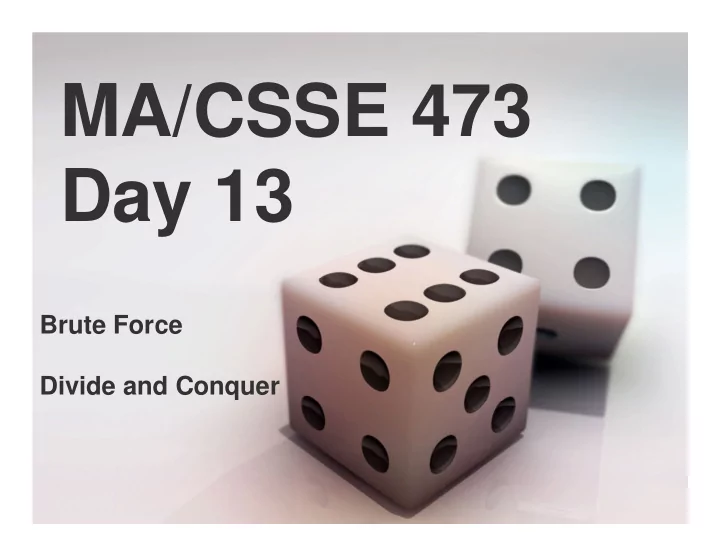

MA/CSSE 473 Day 13 Brute Force Divide and Conquer
MA/CSSE 473 Day 13 • Student Questions • Brute force algorithms • Divide and Conquer
What is the brute force approach to Calculate the n th Fibonacci number? 1. Compute the n th power of an integer? 2. 3. Search for a particular value in a sorted array? 4. Sort an array? 5. Search for a substring of a string? 6. Find the maximum contiguous subsequence in an array of integers? 7. Find the largest element in a Binary Search Tree? 8. Find the two closest points among N points in the plane? 9. Find the convex hull of a set of points in the plane? 10. Find the shortest path from vertex A to vertex B in a weighted graph? 11. Solve the traveling salesman problem? 12. Solve the knapsack problem? 13. Solve the assignment problem? 14. Solve the n × n non-attacking chess queens problem? 15. Other problems that you can think of?
DIVIDE AND CONQUER
Divide-and-conquer algorithms • Definition • Examples seen prior to this course or so far in this course Q1
Closest Points problem • Given a collection, S, of N points, find the minimum distance between two points in S. • Running time for brute force algorithm?
Closest Points divide phase • Given a collection, S, of N points, find the minimum distance between two points in S. • For simplicity, we assume N = 2 k for some k. • Sort the points by x-coordinate. – If we use merge sort, the worst case is Ѳ(N log N) • If two points have the same x-coordinate, order them by y-coordinate. • Let c be the median x-value of the points • Let S 1 be {(x, y): x ≤ c}, and S 2 be {(x, y): x ≥ c} – adjust so we get exactly N/2 points in each subset Q2
Closest Points problem • Assume that the points of S are sorted by x- coordinate. • Let d 1 be the minimum distance between two points in S 1 (the set of "left half" points). • Let d 2 be the minimum distance between two points in S 2 (the set of "right half" points). • Let d = min(d 1 , d 2 ). Is d the minimum distance for S? • What else do we have to consider? Q3 • Suppose we needed to compare every point in S 1 to every point in S 2 . What would the running time be? Q4 • How can we avoid doing so many comparisons?
Quick Review: The Master Theorem • The Master Theorem for Divide and Conquer recurrence relations: For details, see Levitin • Consider the recurrence pages 483-485 or T(n) = aT(n/b) +f(n), T(1)=c, Weiss section 7.5.3. where f(n) = Ѳ(n k ) and k≥0 , Grimaldi's Theorem • The solution is 10.1 is a special case of the Master Theorem. – Ѳ(n k ) if a < b k – Ѳ(n k log n) if a = b k – Ѳ(n log b a ) if a > b k We will use this theorem often. You should review its proof soon (Weiss's proof is a bit easier than Levitin's).
After recursive calls on S 1 and S 2
Convex Hull Problem • Again, sort by x-coordinate, with tie going to larger y-coordinate.
Recursive calculation of Upper Hull
Simplifying the Calculations • The maximum distance of P from line P 1 P 2, and • Determining whether P is "to the left" of P 1 P 2 – The area of the triangle through P 1 =(x 1 ,y 1 ), P 2 =(x 2 ,y 2 ), and P 3 =(x 3 ,y e ) is ½ of the absolute value of the determinant 1 x y 1 1 1 = + + − − − x y x y x y x y x y x y x y 2 2 1 2 3 1 2 3 3 2 2 1 1 3 1 x y 3 3 – The sign of the determinant is positive if the order of the three points is clockwise, and negative if it is counter-clockwise – For a proof of this property, see http://mathforum.org/library/drmath/view/55063.html • Clockwise means that P 3 is "to the left" of directed line segment P 1 P 2 • What about max distance?
Efficiency of quickhull algorithm • What arrangements of points is worst case? • Average case is much better. Why?
Recommend
More recommend